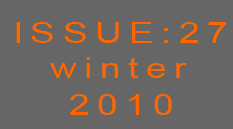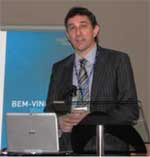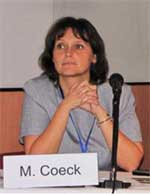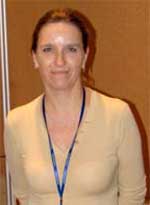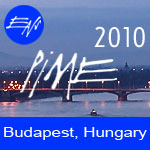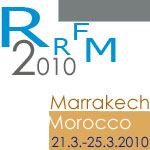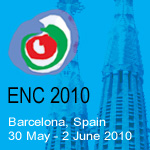

ETRAP 2009: a new approach to education and training in radiological protection
The 4th International Conference on Education and Training in Radiological Protection (ETRAP), organised by ENS in cooperation with the International Atomic Energy Agency (IAEA) and hosted by Portugal’s Instituto Technologico e Nuclear (ITN), was held from 8 - 12 November 2009 in the legendary capital of Portug
al – Lisbon. This truly international event was attended by more than 120 participants from 26 countries. Experts from leading European and international organisations, universities, research institutes and industry representatives shared their experiences in delivering education and training in the field of radiological protection. However, the Young Generation was not represented in equal numbers at the forum.
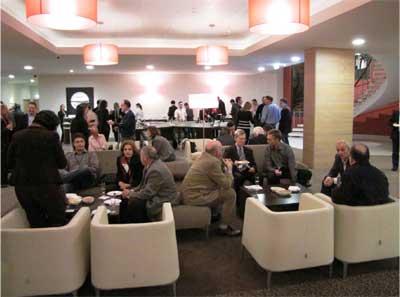
The first social event on the ETRAP 2009 agenda was the Welcome Cocktail. It took place on 7 November at the Novotel Lisboa Malhoa. In a friendly atmosphere fellow delegates met to talk about safety culture issues and to build foundations for future collaboration.
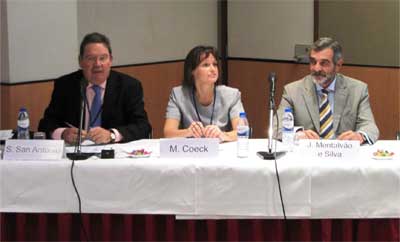
The ETRAP 2009 Official Opening session took place on Monday, 8 November. ENS Secretary General, Santiago San Antonio, chaired the session in which the President of INT Mr. J. Montavao e Silva and the Chairwoman of the ETRAP Programme Committee, Michelle Coeck, gave welcome addresses. As Mr. Montavao e Silva said, Portugal does not have nuclear power plants (only a small 1MW research reactor). Nevertheless, the vast and growing use of nuclear technology based equipment for medical and industrial applications implies a need for radiation protection activities provided by the ITN. Ms. Coeck expressed her satisfaction with the progress made since the previous ETRAP conference in 2005. She outlined the topics of common interest for the audience.
The ETRAP 2009 scientific programme was very dynamic, with 8 sessions for oral presentations and two poster sessions.
The first series of presentations was entitled “Setting the scene” and featured five keynote speakers from the European Commission (EC), the International Radiation Protection Agency (IRPA), the IAEA and the Organisation for Economic Co-operation and Development Nuclear Energy Agency (OECD/NEA), respectively. The first speaker Mr. S. Mundigl, EC Directorate-General for Energy and Transport, who introduced the revised European Basic Safety Standards (BSS) with a special focus on education and training requirements. The good news he gave is that the outcomes of the three workshops, organised within the EUTERP project, have been accepted.
Dr. A. Jouve (EC) then presented the EURATOM framework programme and Prof. E. Gallego (IRPA) introduced the IRPA strategic plan for the next 10 years. He stated that the IRPA will encourage activities to attract young people to the profession and young professionals to the IRPA congresses. Mr. J. Wheatley (IAEA) highlighted the IAEA’s achievements in the field and its future focus on the education and training in radiation protection. IAEA-run post-graduate education courses in radiation protection and safety of radiation sources are open to young professionals with a science/engineering degree. The OECD/NEA speaker Mr. U. Yoshimura raised the issue of the retention of skills and competence in radiation protection.
After lunch, the first poster session provoked intensive discussions.
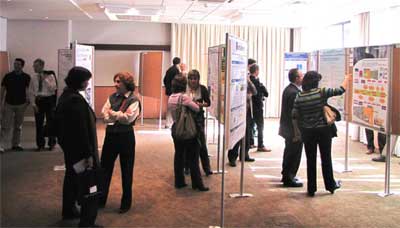
The following two sessions were about current developments in education and training in radiological protection and the developments in training delivery. Among those developments presented were radiation protection training programmes in Malaysia, the EU Joint Research Centre in Ispra (Italy) and Loviisa NPP in Finland. New distance learning systems were discussed. The developments in training delivery included the experiences gained from the PETRUS programme (education in the geological disposal of radioactive wastes), as well as examples from the Republic of Korea and Japan. The first day of ETRAP 2009 was then closed and the delegates had a free evening to explore the fascinating city of Lisbon.

Tuesday morning started with presentations on education and training networks, their achievements and the problems they have encountered. Very informative presentations were given on the ENETRAP project, the EUTERP platform, the role of the Federation of Independent Organisations of Medical Physics in Europe (EFOMP), the European Nuclear Education Network Association (ENEN) and Cooperation for Higher Education on Radiological and Nuclear Engineering (CHERNE). The role of small research reactors in education and training with regards to radiological protection was discussed at the end of the session. The most interesting for me was the presentation of Ms. Coeck. She underlined the specific objectives of the ENETRAP II as initiatives to attract early-stage radiation protection researchers on a European level. I learned that professional networks are involved in projects at different educational levels. Therefore, the possibilities for the young people to get involved are real and prospects for the young generation look quite good.
Another session was dedicated to approaches in sector specific training. The keynote presentation was given by Karl-Michael Schlicke, a representative of Siemens AG, which is a major supplier of medical x-ray equipment. The following five presentations covered nuclear power applications in the medical sector. This session had two parts with a break for the second Poster session.
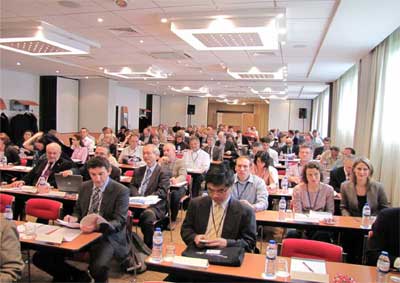
In the afternoon, talks on approaches in sector specific training continued. The urgent need to increase the radiation protection knowledge and awareness of the medical staff (physicians, nurses etc.) was highlighted. This long session finished after a presentation of a successful management model that took place in a Canadian nuclear installation. In short, sector-specific training has proved to be useful but “training is not everything”, as Ms. McQueen of Bruce Power said.
In the late afternoon session on broadening the prospects, education and training programmes offered by Idaho State University, the IAEA, the Belgian nuclear research centre (SCK•CEN) and B.A.D GmbH (Germany) were discussed. The next steps for improving radiation protection culture at a time of nuclear renaissance were discussed.
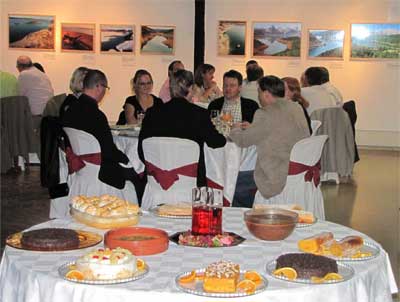
The ETRAP 2009 Conference Dinner took place at the Barbadinhos Steam Pump Station (built in 1880), at the Lisbon Water Museum. The delegates had a memorable evening in wonderful surroundings with a three course dinner and traditional Portuguese drinks. I asked Mr. Schlicke, one of the keynote speakers, for his opinion of the event. He said that it was a good idea to have dinner at a special place. “It provides very special atmosphere.” The food and wine were excellent and he really enjoyed the evening.
The last day of the scientific programme focused on two main topics: recent developments in the recognition and harmonisation of requirements and building the future.
In the first session, the United States’ Nuclear Regulatory Commission training programme was presented. Then the following topics were discussed: requirements for the recognition of radiation protection experts (RPE); radiation protection officers (RPO) and the establishment of European guidance for PRO training and the mechanisms for the evaluation of training materials and trainers. Also, several examples of radiological protection training courses were given, including some in Belarus, Slovenia and Portugal. The speakers agreed that the philosophy for promoting mutual recognition of radiation protection across Europe can be achieved only with the joint efforts of all concerned.
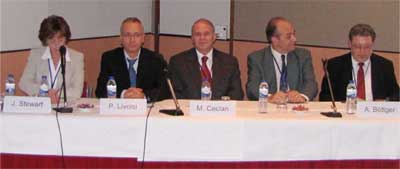
The last - but by no means least important - session was the one on building the future and attracting a new generation. This session was dedicated to European programmes in radiation protection. Dr. A. Bottger talked about the German experience in maintaining competence in radiation protection. He mentioned how a national programme facilitates the involvement of young scientists in Germany.
At the European level, three new European Masters Degree programmes in radioecology, radiation protection and advanced radiochemistry, have been developed. As Prof. Tamponnet (IRSN, France) said, the needs for such programmes have been identified following a stakeholder assessment and carried out within two European projects (EU-EURAC and EU-ENEN). A pilot MSc degree course in Radioecology, funded by the European Commission, will be run by the Norwegian University of Life Sciences. A “work in progress” programme - the ENETRAP II project (enetrap2.sckcen.be/) was presented by Prof. Ceclan, from Romania. The focus of his presentation was “the best means of attracting young people to the field of radiation protection”. The results will be communicated to other networks, such as EUTERP, ENS and ENS-YG. The last presentation in the scientific programme focuses on an ENETRAP outcome: The European Master’s degree in Radiation Protection “EMRP”. The speaker, Mr. Livolsi (CEA/INSTN, France), was delighted that important steps of the EMRP project have been accomplished, including a common programme framework. However, there are issues still to be discussed and sustainable funding to be obtained.
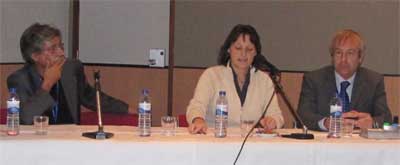
In the closing session, Mr. R. Paynter (Health Protection Agency – UK) summarised the achievements of the past four years. A considerable move forward has been made in the areas of clarification and harmonisation with the two projects: EUTERP and ENETRAP. The Qualified Expert concept has been reviewed and the definitions for Radiation Protection Expert and Radiation Protection Officer have been developed. Three workshops have been organised and all participants gave a commitment to a harmonised approach to radiation protection training. Ongoing international projects and other activities show that the level of international cooperation and commitment to achieving this goal is evolving. The Network structures can meet the needs for ongoing exchange of information on training activities and developments. A rationalisation of the existing networks is necessary to develop a common radiation protection and safety culture and apply a multidisciplinary approach to radiation protection training. These points will be included in a conference declaration, which will be issued later.
ETRAP 2009 ended with closing remarks from Ms. Coeck and Mr. A. Falcao (ITN). The conference organisers were congratulated for the good work done in making the event a success.
The Technical Visit to the ITN took place on Thursday, 12 November. We were introduced to the activities of the institute in the field of nuclear sciences and technologies, radiological protection and safety. I was impressed by the modern laboratories and the great number of young people working there. Also, we visited the 1 MW research reactor and we were allowed to take photos.
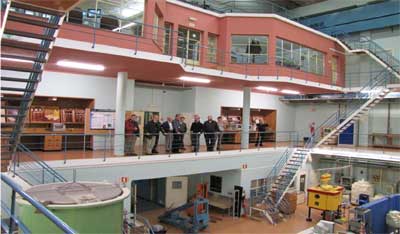
This was my first attendance at an ETRAP conference. My work as a Young Generation Network reporter was a great challenge for me. I think that the ETRAP 2009 was successful because many good presentations were given, very interesting posters were presented along with fruitful discussions and the participants had a good time.
Portuguese hospitality and perfect organisation were the main ingredients for its success. One of the major benefits of the ETRAP 2009 was networking. Unfortunately, not many young people attended the conference. This fact motivated me to collect useful information and share it with the ENS-YG community. During the coffee breaks and lunches I met many interesting people and recorded some of their opinions. Three important messages to the Young Generation can be found at the end of my report.Finally, I hope that more young people will attend the next ETRAP conference because together we will build the future.
I would like to thank the people who made my attendance at the ETRAP 2009 possible: Kirsten Epskamp and my PhD Supervisor Prof. Simon M. Pimblott, the ENS, The University of Manchester and BgNS. Special thanks to Ms. Coeck, Ms. McQueen, Mr. Mundigl and Mr. Schlicke for the interviews.
Pavlina I. Schmitz, MSc, AMRSC
School of Chemistry
The University of Manchester
United Kingdom
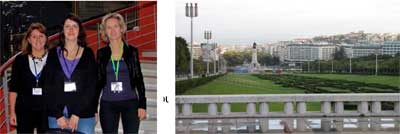
The following four messages to the Young Generation were given during the conference:
|
“Be well-trained and dedicated”.
(Stefan Mundigl, European Commission, Directorate-General for Energy and Transport, Radiation Protection Unit) |
|
“Radiation protection is a major challenge in the industrial applications of ionising radiation. There is a trend of decreasing the number of experts in radiation protection due to various reasons. On the other hand, the current activities in the nuclear domain are expanding: the nuclear industry faces a so-called "renaissance".
To ensure the safe use of ionising radiation is of utmost importance for all applications (nuclear industry, non-nuclear sector and medical). Currently, a
|
significant part of the personnel retire and there are not enough new and young people to come. The challenge is to fill the gap and prepare for the future. One thing that will help is giving the young professionals a possibility to learn about radiation protection science, its fields of application, importance of the radiation protection tasks in different nuclear industries whose main aim is not radiation protection.
Important for young people is:
1. to broaden their view: understand the technical and scientific part, but also have a feeling for the philosophical and ethical context of the field they are working in: nuclear in general is difficult, also from social point of view.
2. to build confidence: important to understand and to be able to communicate on "the whole picture", benefits and disadvantages of the technique used, implications for safety of workers and environment.
Why study radiation protection? Because: 1. It is a fascinating science. 2. You can find a job in an industry where ionising radiation is used. This does not automatically mean the nuclear sector, it can also be the non-nuclear or medical sector. 3. You can have a responsibility towards society: you will be able to understand the benefits and the disadvantages of radiation, and you will be able to look over the safety of workers, environment and the public.”
(Michèle Coeck, SCK•CEN - Belgium)
|
“It is as important not only to attract, but also to retain the young generation in radiation protection.
1. We should not just review what is current practice, but we need to talk to the young people in our field and ask them what we need to do and what they are looking for.
2. We need to understand the young generation, review studies on their age/motivation. They do not think or act like us – they are different. They will typically move jobs every few years |
3. We need to use new technologies to network and communicate with young people. We also need to introduce new technologies in the field of RP.
4. We need to expose young people to the depth of our subject area. We need to expose them to experts. They need to be at our conferences, they need to see the importance of the expert.
5. We need to let the young people themselves lead and design how we attract and retain them in our profession.”
(Maurine McQueen, Bruce Power – Canada)
" The Nuclear Sector in general and Radiation Protection in particular is a highly interesting field to work in work due to its technical and societal challenges.
We from EUTERP are working on the recognition of your qualifications to facilitate free movement of workers troughout Europe. "
( Folkert Draaisma,
Coordinator EUTERP Platform,
NRG - The Netherlands)
|

